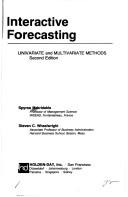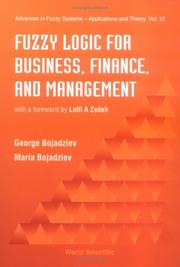| Listing 1 - 5 of 5 |
Sort by
|

ISBN: 0813316510 Year: 1993 Volume: *3 Publisher: Boulder, Colo. Westview Press
Abstract | Keywords | Export | Availability | Bookmark
 Loading...
Loading...Choose an application
- Reference Manager
- EndNote
- RefWorks (Direct export to RefWorks)
Beleidswetenschappen --- Forecasting --- Policy sciences --- Politique [Sciences de la ] --- Prévision --- Sciences de la politique --- Voorspelling --- Data processing --- Mathematical models --- Forecasting - Mathematical models. --- Forecasting - Data processing.

ISBN: 0816254168 9780816254163 Year: 1978 Publisher: San Francisco : Holden-Day,
Abstract | Keywords | Export | Availability | Bookmark
 Loading...
Loading...Choose an application
- Reference Manager
- EndNote
- RefWorks (Direct export to RefWorks)
Planning (firm) --- Mathematical statistics --- Forecasting --- Data processing --- 330.105 --- -65.012.23 --- Forecasts --- Futurology --- Prediction --- Wiskundige economie. Wiskundige methoden in de economie --- 330.105 Wiskundige economie. Wiskundige methoden in de economie --- 65.012.23 --- Forecasting - Data processing --- Economic cycles forecasting --- Time series(Multivariate-) --- Time series(Decomposition method) --- Business cycle forecasting --- Cross autocorrelations --- Multivariate analysis in time series --- Autocorrelation analysis in time series --- Filtering(Adaptive-) --- Time series --- Time series forecasting --- Box-Jenkins model --- Moving averages in statistics --- Smoothing(Exponential-)

ISBN: 9810228945 9812819789 9789812819789 9789810228941 Year: 1997 Volume: 12 Publisher: Singapore ; River Edge, N.J. : World Scientific,
Abstract | Keywords | Export | Availability | Bookmark
 Loading...
Loading...Choose an application
- Reference Manager
- EndNote
- RefWorks (Direct export to RefWorks)
This is an interdisciplinary book for knowledge workers in business, finance, management, and socio-economic sciences. It provides a guide to and techniques for forecasting, decision making, conclusions, and evaluations in an environment involving uncertainty, vagueness, and impression. Traditional modeling techniques do not capture the nature of complex systems especially when humans are involved. Fuzzy logic provides effective tools for dealing with such systems. Emphasis is on applications presented in case studies including Time Forecasting for Project Management, New Product Pricing, Clie
Business forecasting --- Fuzzy logic. --- Artificial intelligence. Robotics. Simulation. Graphics --- Mathematical logic --- Corporate finance --- Decision making --- Fuzzy logic --- System analysis --- Data processing --- E-books --- System analysis. --- Network analysis --- Network science --- Network theory --- Systems analysis --- System theory --- Mathematical optimization --- Nonlinear logic --- Fuzzy mathematics --- Logic, Symbolic and mathematical --- Fuzzy systems --- Business --- Business forecasts --- Forecasting, Business --- Economic forecasting --- Data processing. --- Forecasting --- System Analysis --- Decision making - Data processing --- Business forecasting - Data processing

ISBN: 0792378040 9786610206032 1280206039 0306470187 9780792378044 Year: 2000 Volume: SECS 547 Publisher: Boston : Norwell, Mass : Kluwer Academic Publishers ; Distributors for North, Central, and South America, Kluwer Academic Publishers,
Abstract | Keywords | Export | Availability | Bookmark
 Loading...
Loading...Choose an application
- Reference Manager
- EndNote
- RefWorks (Direct export to RefWorks)
Data Mining in Finance presents a comprehensive overview of major algorithmic approaches to predictive data mining, including statistical, neural networks, ruled-based, decision-tree, and fuzzy-logic methods, and then examines the suitability of these approaches to financial data mining. The book focuses specifically on relational data mining (RDM), which is a learning method able to learn more expressive rules than other symbolic approaches. RDM is thus better suited for financial mining, because it is able to make greater use of underlying domain knowledge. Relational data mining also has a better ability to explain the discovered rules - an ability critical for avoiding spurious patterns which inevitably arise when the number of variables examined is very large. The earlier algorithms for relational data mining, also known as inductive logic programming (ILP), suffer from a relative computational inefficiency and have rather limited tools for processing numerical data. Data Mining in Finance introduces a new approach, combining relational data mining with the analysis of statistical significance of discovered rules. This reduces the search space and speeds up the algorithms. The book also presents interactive and fuzzy-logic tools for `mining' the knowledge from the experts, further reducing the search space. Data Mining in Finance contains a number of practical examples of forecasting S&P 500, exchange rates, stock directions, and rating stocks for portfolio, allowing interested readers to start building their own models. This book is an excellent reference for researchers and professionals in the fields of artificial intelligence, machine learning, data mining, knowledge discovery, and applied mathematics.
Investments --- Stock price forecasting --- Data mining --- Data processing --- AA / International- internationaal --- 305.970 --- 303.0 --- 301 --- Algemeenheden: Autoregression and moving average representation. ARIMA. ARMAX. Lagrange multiplier. Wald. Function (mis) specification. Autocorrelation. Homoscedasticity. Heteroscedasticity. ARCH. GARCH. Integration and co-integration. Unit roots. --- Statistische technieken in econometrie. Wiskundige statistiek (algemene werken en handboeken). --- Techniek van statistische inlichtingen. Organisatie van de statistische enquêtes. Statistische kritiek. --- Investments -- Data processing. --- Stock price forecasting -- Data processing. --- Data mining. --- Data processing. --- Data structures (Computer scienc. --- Artificial intelligence. --- Finance. --- Data Structures and Information Theory. --- Artificial Intelligence. --- Finance, general. --- Data structures (Computer science) --- Forecasting, Stock price --- Security price forecasting --- Stocks --- Business forecasting --- Algorithmic knowledge discovery --- Factual data analysis --- KDD (Information retrieval) --- Knowledge discovery in data --- Knowledge discovery in databases --- Mining, Data --- Database searching --- Techniek van statistische inlichtingen. Organisatie van de statistische enquêtes. Statistische kritiek --- Statistische technieken in econometrie. Wiskundige statistiek (algemene werken en handboeken) --- Algemeenheden: Autoregression and moving average representation. ARIMA. ARMAX. Lagrange multiplier. Wald. Function (mis) specification. Autocorrelation. Homoscedasticity. Heteroscedasticity. ARCH. GARCH. Integration and co-integration. Unit roots --- Prices --- Forecasting --- Data structures (Computer science). --- Funding --- Funds --- Economics --- Currency question --- AI (Artificial intelligence) --- Artificial thinking --- Electronic brains --- Intellectronics --- Intelligence, Artificial --- Intelligent machines --- Machine intelligence --- Thinking, Artificial --- Bionics --- Cognitive science --- Digital computer simulation --- Electronic data processing --- Logic machines --- Machine theory --- Self-organizing systems --- Simulation methods --- Fifth generation computers --- Neural computers --- Information structures (Computer science) --- Structures, Data (Computer science) --- Structures, Information (Computer science) --- File organization (Computer science) --- Abstract data types (Computer science) --- Investments - Data processing --- Stock price forecasting - Data processing
Book
ISBN: 1461420490 9786613445766 128344576X 1461420504 Year: 2012 Publisher: New York : Springer,
Abstract | Keywords | Export | Availability | Bookmark
 Loading...
Loading...Choose an application
- Reference Manager
- EndNote
- RefWorks (Direct export to RefWorks)
“The trend is your friend”is a practical principle often used by business managers, who seek to forecast future sales, expenditures, and profitability in order to make production and other operational decisions. The problem is how best to identify and discover business trends and utilize trend information for attaining objectives of firms.This book contains an Excel-based solution to this problem, applying principles of the authors’ “profit system model” of the firm that enables forecasts of trends in sales, expenditures, profits and other business variables. The program, called FIRM, which runs on Windows with Microsoft Excel 2010, useshistorical time series of total sales, total costs, and total assets of the firm from its financial statements (income statements and balance sheets), estimates relationships among these variables, and then employs the estimated relationships to forecasts trends in these vital business variables. Featuring step-by-step case examples, the goal is to equip business managers and students with easy-to-use tools for understanding and forecasting trends in important business variables, thereby empowering them to make better business decisions. .
Business forecasting -- Data processing. --- Microsoft Excel (Computer file). --- Business forecasting --- Decision support systems --- Electronic spreadsheets --- Commerce --- Management --- Business & Economics --- Management Theory --- Local Commerce --- Data processing --- Computer programs --- Business cycles --- Business --- Forecasting. --- Computer programs. --- Microsoft Excel (Computer file) --- Economic cycles --- Economic fluctuations --- Microsoft Excel for the Macintosh --- Microsoft Excel for Windows --- Excel (Computer file) --- Excel for Windows --- Microsoft Excel for Windows 95 --- Excel 97 --- Microsoft Excel 97 for Windows --- Excel 2000 --- Excel 2000 for Windows 95 --- Microsoft Excel 2002 --- Microsoft Office Excel 2003 --- Excel 2003 --- Microsoft Excel 2007 --- Excel 2007 --- Excel 2010 --- Microsoft Excel 2013 --- Excel 2013 --- Business. --- Management science. --- Business and Management. --- Business and Management, general. --- Cycles --- Trade --- Economics --- Industrial management --- Quantitative business analysis --- Problem solving --- Operations research --- Statistical decision --- Microsoft Excel 2016 --- Excel 2016
| Listing 1 - 5 of 5 |
Sort by
|

 Search
Search Feedback
Feedback About UniCat
About UniCat  Help
Help News
News